Grey squirrels, Rabbits, Foxes, Shrews, Dormice, Field Mice, Moles, Muntjac deer, a Puma? You may see some of these mammals in Furzefield, but not all of them. |
|
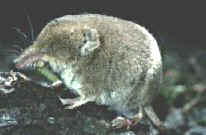 COMMON SHREW(Sorex
araneus) COMMON SHREW(Sorex
araneus)Shrews are mouselike in general appearance but have longer, pointed snouts, small ears, and tiny eyes. Their fur is short and dense and usually brown or grey in colour and is very soft, like a mole. Most shrews are terrestrial and commonly live near streams or other moist sites. Shrews are the smallest of all living mammals. Because of their high metabolic rate, shrews must normally eat about two-thirds of their body weight in food each day. Under certain conditions, such as when nursing young, this intake may be much higher. Shrews feed mainly on insects but commonly take a wide variety of animal foods. Shrews communicate with high-pitched squeaks, often in the ultrasonic range beyond human hearing. You may find dead shrews in the wood as they are apparently unpleasant to the taste and are often left after being killed. |
|
Dormouse is the common name of several species of rodents belonging to the family Myoxidae. Dormice are 5 to 19 cm long, with a tail 40 to 165 mm long. Dormice resemble small squirrels and are found in Eurasia and Africa. They fatten in summer and stay dormant in winter. Litters number two to nine. Furzefield wood is ideal habitat for them since they are said to stripped hazel bark to make their nests. I never saw any in the wood myself. |
|
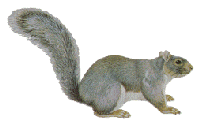 GREY SQUIRREL (Sciurus
carolinensis) GREY SQUIRREL (Sciurus
carolinensis)As we all know the grey is an import from North America. Typical of tree squirrels, the grey has displaced the smaller native red squirrel, (S. vulgaris), in many regions of the UK. Nesting is normally in tree hollows; grey squirrels also may construct leaf nests called dreys, which are used mainly as feeding shelters. Grey squirrels may breed in midwinter and again in late spring. Gestation is about 44 days, with usually two to four young per litter. |
|
| MUNJAC DEER (Muntiacus reevesi)
|
|
 POTTERS BAR PUMA (Puma
concolor?) POTTERS BAR PUMA (Puma
concolor?)You heard the reports back in late 1998 - we had the press in a frenzy over sightings of a large cat believed to be a puma. The puma, Puma concolor, in the family, Felidae, is also called mountain lion or cougar. Pumas range from British Columbia through South America to Potters Bar;-) they prefer forested areas and jungles and can adapt to various climates. A male puma may grow to be 1.8m long, plus a tail of 60-90cm, and may weigh more than 91kg. The coat ranges in colour from reddish to brownish yellow or gray. Black stripes reach from the mouth to the eyes, and the tail tip is black. The head is small and round with a black spot over the eyes. The puma usually hunts at night. Pumas usually live to be about 12 years old. |
|
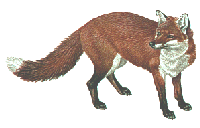 RED FOX (Vulpes
vulpes) RED FOX (Vulpes
vulpes)The fox is the smallest member of the dog family, Canidae. Foxes usually weigh under 7kg. They scavenge carrion and wild fruits and hunt small rodents, rabbits, birds, and invertebrates. Because they hunt small prey sufficient to feed only one animal, foxes are solitary predators and do not hunt in packs. A pair of red foxes normally occupies a territory of 2.5 to 8sq km, which they defend against other foxes. The male and female mate during midwinter, and four to seven young are born between February and May after a gestation period of 51-54 days. The dog fox brings food to the vixen while she is nursing; later both parents feed the pups. By midsummer the young foxes begin to hunt on their own and are self-sufficient by autumn. During early winter the family group breaks up, and the young leave the territory. |
|
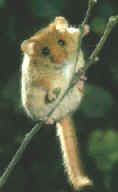 COMMON
DORMOUSE (Muscardinus avellanarius)
COMMON
DORMOUSE (Muscardinus avellanarius)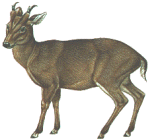 Muntjacs are small deer of the genus
Muntiacus in the family, Cervidae. They are sometimes
called barking deer because of their short, hard cry,
resembling a dog's bark. They are chestnut to yellowish
brown in colour, about 60cm high at the shoulders, about
1m long, and usually less than 20 kg in weight. Adult
males have small antlers, about 13cm long, usually
unbranched except for a small front tine; each antler is
set on top of an elongated, bony structure (the pedicel),
about as long as the antler. The males have small tusks
that protrude beyond the lower lip. Muntjacs are
solitary, living in woodland thickets. Mating occurs
year-round in the tropics but usually in January and
February in the north. Gestation is six months, and the
does bear one to two spotted fawns. The Chinese muntjac,
M. reevesi, a small deer native to Asia and adapted to
cold winters, has been introduced in small numbers into
France and England. The male has short antlers -- usually
a large branch plus a smaller tine -- that are shed each
year.
Muntjacs are small deer of the genus
Muntiacus in the family, Cervidae. They are sometimes
called barking deer because of their short, hard cry,
resembling a dog's bark. They are chestnut to yellowish
brown in colour, about 60cm high at the shoulders, about
1m long, and usually less than 20 kg in weight. Adult
males have small antlers, about 13cm long, usually
unbranched except for a small front tine; each antler is
set on top of an elongated, bony structure (the pedicel),
about as long as the antler. The males have small tusks
that protrude beyond the lower lip. Muntjacs are
solitary, living in woodland thickets. Mating occurs
year-round in the tropics but usually in January and
February in the north. Gestation is six months, and the
does bear one to two spotted fawns. The Chinese muntjac,
M. reevesi, a small deer native to Asia and adapted to
cold winters, has been introduced in small numbers into
France and England. The male has short antlers -- usually
a large branch plus a smaller tine -- that are shed each
year.